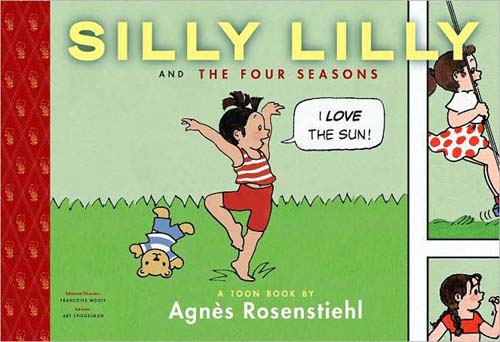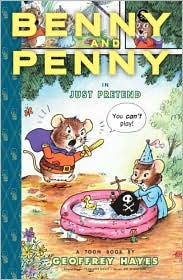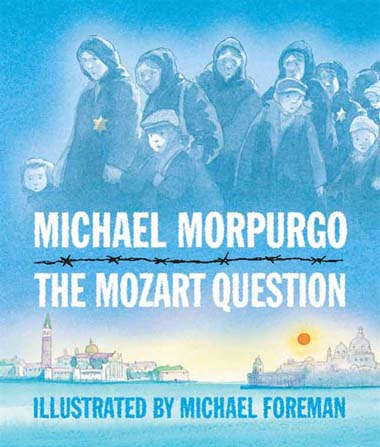Blurring the Lines
 April 15th, 2008 by jules
April 15th, 2008 by jules
Last September, Betsy Bird wrote a smashing piece at ForeWord Magazine’s “Shelf Space” column about books, as she put it, “that refuse to be neatly arranged under a single category. They straddle the genres.” The new titles I’m covering today could fall into this category, I think, but more simply, I think they are examples of what Eisha noted last week when we guest-blogged over at School Library Journal’s Practically Paradise. When I asked Eisha if she has a favorite current trend of children’s lit, here’s what she wrote:
I love that more and more middle grade and YA novels are incorporating heavy amounts of illustrations to support the story, bending the genre lines between straight novels, picture books, and graphic novels.
To that I add the ever-so eloquent, word. Word up, even.
Today I’m going to mention some new illustrated titles I think are worthy of our attention. They’re not necessarily all middle grade or YA, as Eisha mentioned, but they are the types of books that aren’t normally as heavy on illustration as these titles are.



by
Agnès Rosenstiehl
May 2008
by Geoffrey Hayes
April 2008
by Frank Cammuso
and
Jay Lynch
June 2008
If you’re a big kidlitosphere reader, I’m sure you’ve heard about these new TOON Books from The Little Lit Library (a division of Raw Junior, LLC), launched by Françoise Mouly and Art Spiegelman. These are technically what are called emerging reader titles anymore, but the idea here is that these are comics (designed for children ages four and up), which beginning readers can read to themselves. “The artistic and literary qualities that we hope are at the core of the TOON Books are often lacking in standard easy-to-read books, which tend to be made with good intentions but little creative impulse,” said Mouly in this interview from the wonderful new Notes from the Horn Book. “How is a child going to learn to read if she is presented with books that offer none of the pleasures of reading?”
Mouly and Spiegelman decided to ask a whole slew of artists from a wide range of backgrounds to illustrate these titles — established children’s book authors, cartoonists, and some new talent, too. Their first three titles are pictured here, and you’ll notice that Benny and Penny: Just Pretend was released this month; Silly Lilly and the Four Seasons comes out next month; and Otto’s Orange Day will be released in June. I received and read some ARCs of these titles back in December (and already mentioned in this post that, since then, I’ve been playing Benny and Penny ad nauseum with my wee’est girls. They. can’t. get. enough. of. Benny. and. Penny.)
You have heard and you will hear comic books being touted as a trend. I don’t know about you, but I think we’re past that. What matters is taking a hard look at the books themselves: Are they high-quality literature for children? I think these TOON Books, at least these released thus far, are total winners. So, now I sound like a motivational speaker, but I think these work on every level a good book for children should. They might be marketed as a contemporary spin on emerging readers, but bottom line is that they deliver what every good book for children should: an engaging story with strong characters in a vivid setting. Benny and Penny, in particular . . . can I just say? LOVE IT. Couldn’t be better. This is a domestic drama of the highest sort and draws children in — not unlike a multi-colored display of gummy worms in a candy-shop window — with its intense drama (basically: little rodent brother shuns little rodent sister in his pirate play, including spewing hateful words at her, yet comes around at the end with an entirely believable, non-heavy-handed — thank goodness — apology) and emotionally-laden sibling rivalry. The story is laid out in panels with speech balloons — really, again, these are comic books — and Geoffrey Hayes’s illustrations are endearing and action-packed, his storytelling skills spot-on. (See here for an interview with Hayes). Publishers Weekly wrote in their review, “{a} close-range perspective gives readers a good look at Benny and Penny’s facial expressions, supplying the context for the dialogue. These skillful drawings do just what they attempt: they lever beginning readers right into the story.” Go see for yourself. Really, this is one of the best books for children I’ve seen all this year.
Silly Lilly is geared at children even younger than four (certainly not for reading to themselves, but for reading to), as it features an exuberant young girl simply celebrating the seasons — at the park with her bear in Spring; at the beach in Summer; picking apples in Fall; and playing in the snow in Winter (with a return to Spring — and a swing — at the end). This one was created by acclaimed French illustrator Agnès Rosenstiehl, who lays out in four simple, bright panels, sequenced horizontally on each spread, the ever-curious Lilly who sets out to celebrate and discover her immediate surroundings. It’s this potent sense of wonder to which young children can relate; Rosenstiehl nails it.
And Otto’s Orange Day is a bizarre — but also well-crafted — tale (this one divided into chapters) of a cat whose favorite color is orange. He inadvertently releases a genie in an orange lamp his Aunt Sally Lee’s sent him and wishes for an orange-hued world. Not surprisingly, Chapter Two is entitled, “Be Careful What You Wish For!” (Otto’s simply not ready for orange lambchops and is seriously bummed when he can no longer profess to having the blues: “What do you mean? What’s the blues . . . You mean you’ve got the oranges!” his friend tells him). This one was created by Jay Lynch, founder of one of the first underground comics of the ’60s (Bijou Funnies), and political cartoonist and writer Frank Cammuso. This is the busiest comic book of the three (in terms of action and panel clutter, though this isn’t distracting either), working harder to appeal to modern readers (the genie with a very urban look). And Otto’s tale and lesson-learned will appeal to budding nonconformists everywhere.
The TOON Books site reveals new Fall releases already lined up. I’m there. An auspicious beginning to a new-series idea if ever I saw one.
 Candlewick just released in February what I suppose we can call an illustrated novella, written by Michael Morpurgo and illustrated by Michael Foreman. The book tells the story of Paolo Levi, famous fictional violinist who strikes fear into the heart of the rookie journalist suddenly assigned to interview him (her tale of how this interview made her want to become a writer book-ends this story). Warned not to ever ask him “The Mozart Question,” she instead asks him what made him pick up the violin as a child and start playing, thus launching him into the story of how, as a boy, he befriended an old street violinist, sixty-two-year-old Benjamin Horowitz. When the boy tells the violinist that his papa plays the violin — yet refuses to ever get it out — Benjamin convinces the boy Paolo to bring the violin to his home to mend. Eventually, he teaches him to play, as well as persuades him to confess his love of the violin to his parents, which the boy agrees to do on one condition — that Benjamin go with him when he does so.
Candlewick just released in February what I suppose we can call an illustrated novella, written by Michael Morpurgo and illustrated by Michael Foreman. The book tells the story of Paolo Levi, famous fictional violinist who strikes fear into the heart of the rookie journalist suddenly assigned to interview him (her tale of how this interview made her want to become a writer book-ends this story). Warned not to ever ask him “The Mozart Question,” she instead asks him what made him pick up the violin as a child and start playing, thus launching him into the story of how, as a boy, he befriended an old street violinist, sixty-two-year-old Benjamin Horowitz. When the boy tells the violinist that his papa plays the violin — yet refuses to ever get it out — Benjamin convinces the boy Paolo to bring the violin to his home to mend. Eventually, he teaches him to play, as well as persuades him to confess his love of the violin to his parents, which the boy agrees to do on one condition — that Benjamin go with him when he does so.
When Paolo’s parents meet Benjamin, they’re struck speechless for a bit. Turns out they all three know one another, having been transported by train together to a concentration camp during World War II,
all bound for the gas chamber and extermination like so many millions. They survived only because they were all able to say yes to one question put to them by an SS officer, on arrival at the camp. ‘Is there anyone among you who can play an orchestral instrument, who is a professional musician?’
Thus begins their attempts to literally play for their lives (“‘We fought back with our music,’ Papa said. ‘It was our only weapon.'”) Paolo learns, as the three of them recount their horrific ordeal in the camps, that his father could speak no Polish and his mother no Italian, yet “their eyes met as they were playing—as often as possible . . . it might have been their shared joy in music-making, but very soon they knew they loved each other.”
In an impassioned Author’s Note, Morpurgo writes about how “the most haunting image {from the Nazi concentraion camps during the Second World War} does not come from literature or film but from music” and about how, in order to calm new arrivals at said camps, “the musicians were made to serenade them as they were lined up and marched off, many to the gas chambers. Often they played Mozart.” In the story, Paolo’s father asks him, as a budding musician, to never play Mozart in public, for this reason — the “Mozart Question” of the book’s title (and source of confusion for the journalist).
Haunting, indeed, and he succeeds on some levels with this story (pacing, fluctuating tone to keep you on your toes, characterization), but I found myself a bit distracted by its sentimentality — as well as the shifting points-of-view (from journalist to boy to Benjamin to the parents and back again). Certainly, the underlying theme of the-arts-as-healer, one of my favorite themes of all, is a strong one and will please music-lovers, in particular (more like arts-as-life-saver, in this instance). But it was too treacly for me in spots. Foreman’s illustrations are luminous, as usual, yet he knows how to subdue tone and darken his palette for the concentration camp spreads with men and women lined up, most likely on the way to their death.
Also worth nothing: This is a small, square book. Nothing profound in that; you just don’t see books that size too terribly often . . . All in all, this title would serve as a good introduction in Holocaust or WWII units. It isn’t a picture book and isn’t necessarily YA. It straddles. It’s an illustrated novella probably best geared at the middle-grade crowd.

I’ve got them all and love them for all the reasons you mention. My son flat out adores “Benny” and “Otto” – they are going over way better than any of the early reader books. I’m thrilled with this new trend and I hope it keeps up; Toon Books is certainly off to a great start.
Yep, Colleen, it’s good stuff. I look forward to the Fall releases.
I’ve been anxious to see these ever since I heard they were making them, but alas that I have not yet held one in my hand. I have Benny and Penny on order, though, so soon.
I hadn’t seen the TOON books, but I love the concept.
And the very idea of Michael Morpurgo and Michael Forman collaborating on a book gives me the good-shivers.
I love the “Toon” concept…I’m pretty sure that I learned to read by snatching comic books from my brother’s collection. (Jules, I’m sure you can imagine how THAT went over.)
[…] ‘Blurring the lines’ (Illustrations for everyone! A great article about the newest trends in emergent readers, and all […]
Glad you posted about TOON Books–it’s such a great venture and they’ve offered to send us stuff, but we try to stick to MG and YA. I hope you guys do more posts like this one!
[…] Bringing early-reader titles to children but in a comic book format. (I also posted about them last April here at 7-Imp, in which I admit to sounding not unlike a motivational speaker. I also talked about […]